 [Image: The earth 600 million years ago, in the late Precambrian Era; mapped by Ron Blakey].
[Image: The earth 600 million years ago, in the late Precambrian Era; mapped by Ron Blakey].In fact, I think Blakey should be given some sort of science prize for putting these together; these help to visualize broad historical processes in a way that is visually clear, conceptually unforgettable, and imaginatively provocative, to say the least. And these images, posted here, are only one series among many that Blakey's assembled – and these aren't even all the images in that series. For that, you'll have to visit Blakey's site.
So what you're looking at here is continental drift over a period of 600 million years, beginning with the Late Precambrian Era, above, through to the present day, in the penultimate image, below.
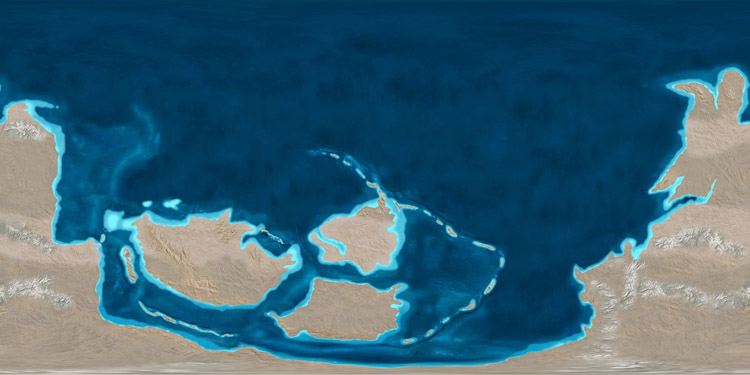
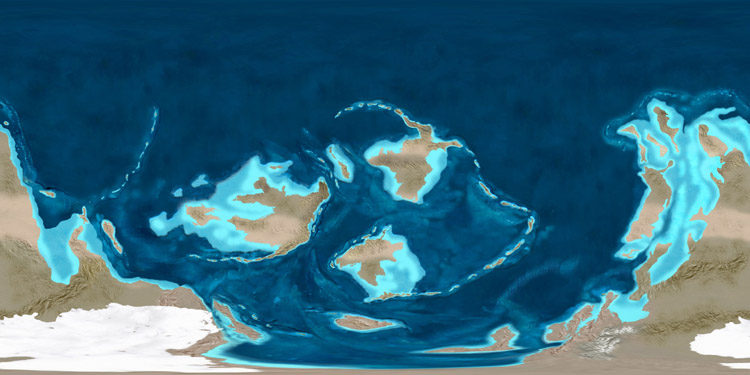
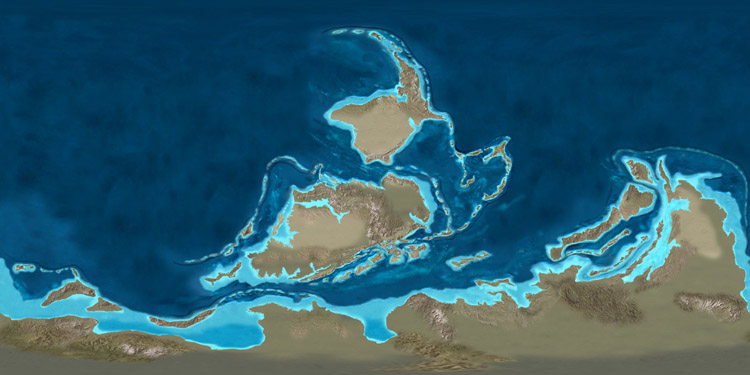
 [Images: The tectonic paleo-history of the earth; mapped by Ron Blakey].
[Images: The tectonic paleo-history of the earth; mapped by Ron Blakey].That sequence of four images, above, gives us the earth as a kind of northward spray of island arcs and micro-continents, small landmasses moving toward evolutionary isolation.
What must it have been like, I wonder, if we could somehow have taken a sailboat in and around those tropical seas, weaving through vast semicircular island chains, finding reefs and bays, lagoons and inlets, anchoring offshore and camping on the beaches of an absolutely dark earth, electricity-less and lit from above by stars – with all the constellations different back then, as even the galaxy itself is still unfolding, full of alien patterns in the sky.
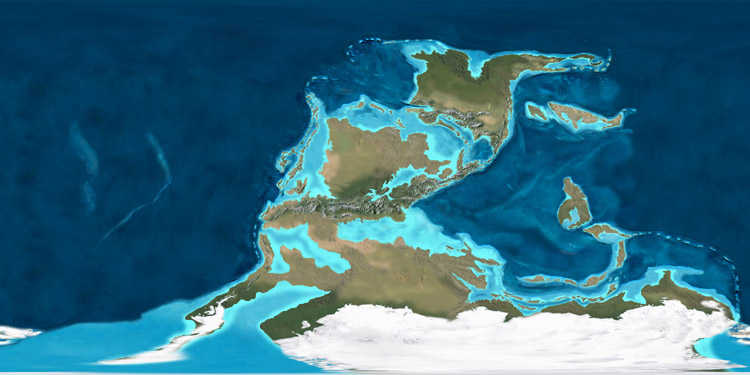

 [Images: The tectonic paleo-history of the earth; in the last two images, you can see recognizable landmasses just beginning to form. Maps by Ron Blakey].
[Images: The tectonic paleo-history of the earth; in the last two images, you can see recognizable landmasses just beginning to form. Maps by Ron Blakey].Something else that fascinates me – and you can see this in the next three images – is the fact that, until relatively recently, Europe was actually an Indonesia-like archipelago, distributed throughout warm northern latitude waters. One of the residues of this geography is a massive fossilized reef that I wrote about here on BLDGBLOG almost exactly two years ago.
Referring to that reef in an article from 1991, New Scientist wrote that, "if we could travel 160 million years back in time," we would find a reef "that occupied most of what is now Europe."
- At first sight this reef and its communities have striking similarities to the Great Barrier Reef. But this ancient reef structure is unique; its main architects were not corals, but multicellular marine sponges, many of which have no match today. And this reef was even bigger than the Great Barrier Reef. Its fossil remains stretch about 2900 kilometeres from southern Spain to eastern Romania, making it one of the largest living structures ever to have existed on Earth.


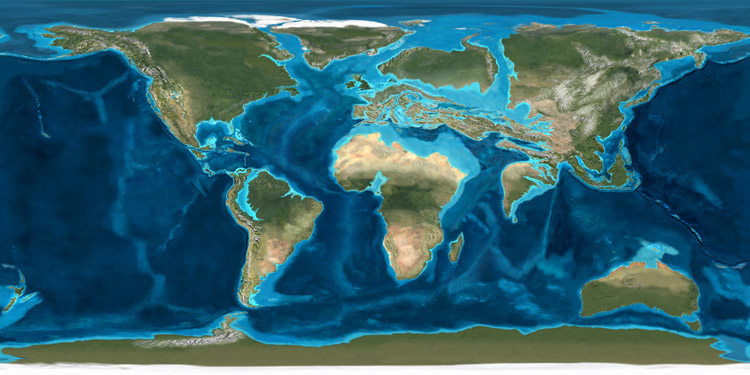 [Images: The earth from roughly 150 million years ago to 50 million years ago; mapped by Ron Blakey].
[Images: The earth from roughly 150 million years ago to 50 million years ago; mapped by Ron Blakey].Then, of course, we hit the present day – pictured below.
Suddenly this arrangement looks rather impermanent.
 [Image: The earth in its present continental configuration; mapped by Ron Blakey].
[Image: The earth in its present continental configuration; mapped by Ron Blakey]. It's extraordinary to realize, then, that this sequence of images represents only 600 million years of geological time – because the earth has something like seven and a half billion years to go before solar extinction. And though plate tectonics may actually cease someday, let's say that a healthy billion and a half more years of continental rearrangement are still in store for this world; what fantastic inland seas and archipelagos might yet be waiting to form?
Extrapolating from these very images into the future, as our planet continues to delink and spread, maneuvering its surfaces around in endless reconfigurations, is a time-consuming but worthwhile thought experiment; if we could get Blakey to speculate upon the tectonic future of the earth, for instance, that would indeed be something to see.
Of course, this is something that New Scientist actually wrote about this past winter, suggesting three possible evolutionary scenarios for where these nomadic fragments of our planet's surface might end up:
- Geologists now suspect that the movements of the Earth's continents are cyclical, and that every 500 to 700 million years they clump together. Unfolding over a period three times as long as it takes our solar system to orbit the centre of the galaxy, this is one of nature's grandest patterns. So what drives this cycle, and what will life be like next time the continents meet?
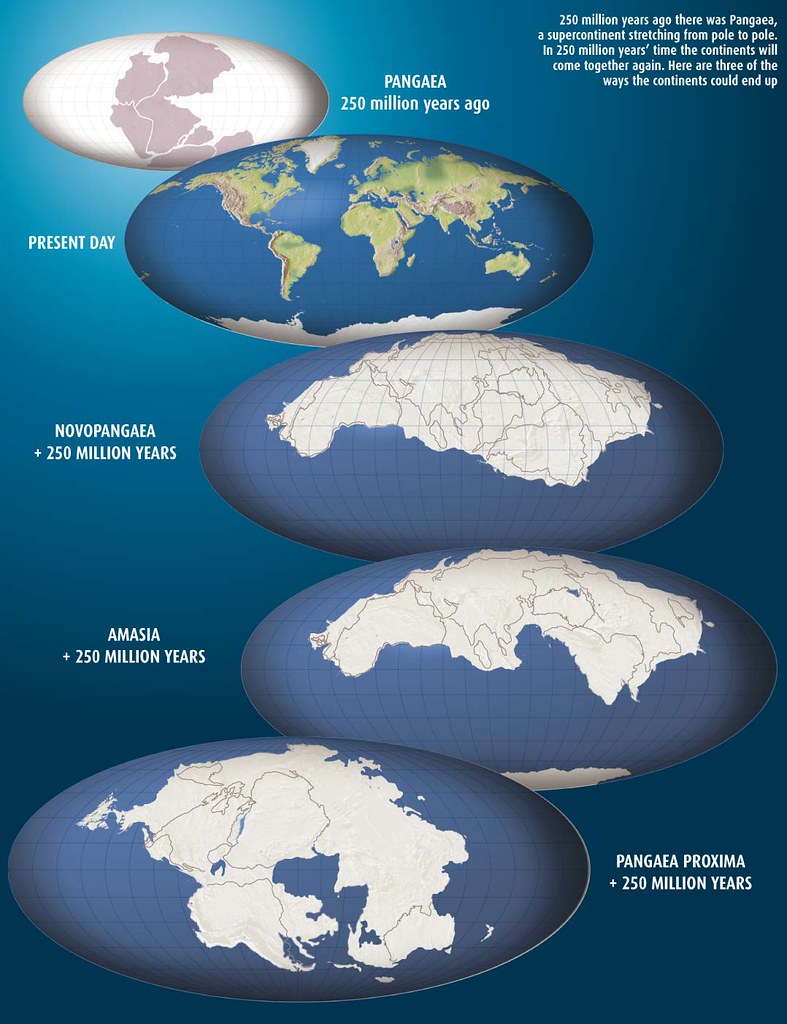 [Image: Three possible supercontinents, as mapped by New Scientist: Novopangaea, Amasia, and Pangaea Proxima; view larger].
[Image: Three possible supercontinents, as mapped by New Scientist: Novopangaea, Amasia, and Pangaea Proxima; view larger].As if these things are a matter of preference, let me absurdly point out that I am actually not a big fan of supercontinents; I think they're boring. Luckily, they seem to crack apart based upon their own weight and bulk; in other words, like many Americans, supercontinents are too heavy for their own good.
Personally, I like archipelagos and island arcs.
In fact, might there be some way to hack the earth's surface and ensure a supercontinent-free planet to come? We could somehow help certain portions of the earth's surface to unzip, forming new island chains, and we could perforate continental shields the world over to assist with their future fragmentation...
In any case, what's also interesting about these maps is that, taken as a whole, the last 600 million years appear really to have been a kind of mass northward migration of landmasses, as if the continents were pulled from one pole to the other by temporary, if monumental, spreading and subduction zones.
Again, though, these are not all the images in the series; for that, you'll have to check out Ron Blakey's website. And, seriously, someone needs to give this guy a fellowship or an award or something – these maps are just fantastic.
[Image: These images are also available in a small Flickr set].
No comments:
Post a Comment